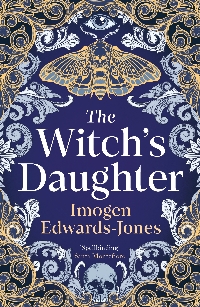Blog tour: The Witch's Daughter by Imogen Edwards-Jones

This post is part of a blog tour organised by Random Things Blog Tours. I received a free copy of the book in return for an honest review.
‘A city burning. A revolution raging. A woman on the run.
‘Nadezhda has never wanted to be a witch. But the occult is in her blood. Her mother, Militza, conjured Rasputin and introduced him into the Romanov court, releasing the devil himself. Now he is dead, but Militza still dreams of him – stalking her sleep and haunting her waking hours.
‘As Petrograd burns and the Russian Empire crumbles, Nadezhda escapes through the capital, concealing a book of generational magic. But as danger grows closer, she may be forced to embrace her heritage to save what she loves most…’

The Witch’s Daughter, by Imogen Edwards-Jones, continues the story of The Witches of St Petersburg. Having used their occult powers to manifest Rasputin, causing chaos beyond what they envisioned, regretful sister witches Militza and Stana have destroyed their creation, but he’s far from stuffed back into the bottle.
With the losses and privations of World War I becoming more and more acute, unrest among Russia’s peasants and proletariat escalates into revolution, and the ‘vices, crime and filth’ the Mad Monk predicted in the event of his death proliferate.
Nobles like Militza and Stana are no longer safe in Petrograd, and are forced to flee to their summer palaces in Crimea, where their presence is slightly better-tolerated by the locals – for now, at least.
Militza’s daughter Nadezhda is among their number. Considering herself modern and rational, Princess Nadezhda holds no truck with her mother and aunt’s unorthodox beliefs, but grudgingly agrees to help protect the one book they absolutely must hold on to. When her Montenegrin ancestors’ methods help her at peak times of need, though, she becomes far more open to the power of magic.
I found The Witch’s Daughter a really enjoyable read. Even though I hadn’t read The Witches of St Petersburg – but now plan to! – I found it relatively easy to get up to speed and absorb myself in the story.
Of course, this book was always going to be right up my street, as studying the Russian Revolution many years ago for my History A-Level piqued my interest, and I’ve enjoyed novels set in that time and place ever since. The Witch’s Daughter fulfilled my expectations in that respect, but also answered a question I’d never previously considered: we all know what became of the Tsar and his most immediate family, but what about his other relatives?
Despite their privilege and position on the wrong side of history, Edwards-Jones writes many of these characters in such a way that you care about what happens to them. Nadezhda is the most obvious example of this – and, as the central character, the most important for the author to get “right”.
She goes through intense experiences of love and loss that virtually anyone can empathise with, and understands the people’s plight, even if she abhors the extreme violence and senseless destruction that transpires (and I couldn’t blame her for that, whether she was personally affected by it – which she is – or not).
In fact, quite a few members of Nadezhda’s circle are surprisingly cognisant of the suffering around them, and can see why the masses hate them so much.
Even the older, more traditional aristocrats volunteer as nurses, set up hospitals, and travel to the front to aid wounded soldiers. While these are not purely selfless acts (optics are important, after all), they still made me feel warmer towards these characters than I might have done otherwise, especially when they were clearly affected by what they witnessed.
When particular dukes, duchesses, princes and princesses in this story aren’t so sympathetic, though, there are other things that keep you hooked. One is humour: there are continual laughs to be had from upper-class people complaining about having to do everyday things for themselves, the décor of the palace they’re occupying, or the lack of entertainment in Crimea in the off-season.
The other is intrigue: Militza and Stana often come across as cold and hard, but I want to know more about their supernatural powers, and what’s in the library they have to leave behind!
In fact, despite the title and blurb, while witchcraft is a USP of this novel, it fades into the background a lot of the time. The precious green velvet-bound book, meanwhile, spends a lot of the story not in the possession of Nadezhda, but Albert (Bertie) Stopford – an affable and entertaining British antiques dealer, diplomatic courier, and confidante of the glamorous Grand Duchess Vladimir.
It does feel, then, that the marketing of this book could make a little more of other reasons to read it: the fascinating, vividly-portrayed historical setting; the amount of research and attention to detail that’s gone into it; and the suspense as the characters repeatedly find themselves in mortal danger.
The Witch’s Daughter is fascinating and gripping, with well-drawn characters.
